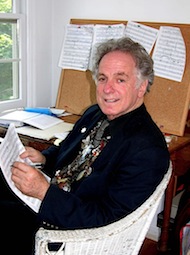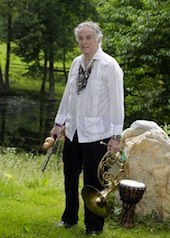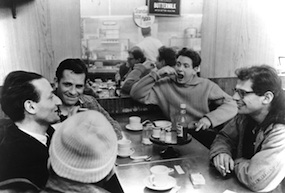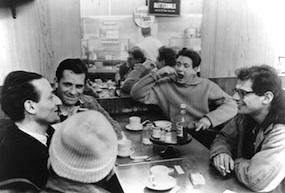
Most of the notables involved in what may have been the first-ever jazz-poetry reading of the so-called Beat Generation have passed on into legend. Of those presenting at that event, at the Brata Art Gallery on East 10th Street in Manhattan in October 1957, the sole survivor is the “jazz” cat David Amram, a French horn virtuoso, multi-instrumentalist, and composer. The now-departed poets were Amram’s longtime buddy and notorious novelist Jack Kerouac, San Francisco native Philip Lamantia, and Lamantia’s friend Howard Hart. Amram had already studied with Gunther Schuller and gained notice as an undeclared proponent of the Third Wave, playing in classical and jazz arenas and composing for theater and film. He continued writing in those contexts, and in 1966 was chosen by Leonard Bernstein as the New York Philharmonic’s first composer in residence. Over the next four decades, he expanded into orchestral and operatic settings, as well as work for soloists and small ensembles, and he recorded, conducted, and performed as an instrumentalist. On Sept. 26, Amram will celebrate the 54th anniversary of the Brata Gallery collaboration with readings and music at the Beat Museum in San Francisco’s North Beach neighborhood. He’ll then be on the road toward a week’s stay in San Jose, where the Symphony Silicon Valley will perform two of his compositions, with Amram as featured soloist, on October 1 and 2. The perpetually young and restless 81-year-old spoke with SFCV from his home near the Hudson River, in New York State.
Performing your work in San Jose, you’ll be in an area you lived in before beginning your music career, right?
I’d been back before, when the Symphony Silicon Valley did my Triple Concerto the first time [2005], and at that time I revisited a lot of the places I’d been in 1948. I lived in Palo Alto then with my high school sweetheart, Julie Mears, and her family, and I worked as a carpenter’s helper. I used to come down to North Beach, and you know that was a different world then. I got a week off, and I went with my girl to the Bach Festival in Carmel, and sang. And one of the people in the chorus was a big Stan Kenton fan who was a good classical singer, but was also scat-singing and playing bebop records. There was already what you might call a cross-cultural sensibility.
Featured Video
Amram conducts and plays bonsri in the Rondo a la Turca from his Triple Concerto, with members of the Chicago Symphony Orchestra, in 1977.
So the Symphony will be doing your Triple Concerto again.
It’s for woodwind, brass, jazz quintets, and orchestra, and this time I’ll be playing the piano and a little metal whistle. I’ll also be playing the dumbek [a Middle Eastern and North African goblet drum]. And hopefully, in addition to being a soloist, I’ll be a “super sideman” in one of the three quintets. Part of the gestalt of our earlier eras was that anybody who was a bandleader, or got special appreciation, tried to incorporate that in a group effort. When you hear Lester Young playing with Billie Holiday, Charlie Parker, or Dizzy Gillespie when they were backing up a singer or one another, or John Coltrane with that wonderful singer Johnny Hartman, they were [jazz stars who were] also the masterful accompanist. And James Levine, an extraordinary conductor, when he’d play piano for a singer or cellist or violist, he was a masterful accompanist. Which was one reason why he was such a good opera conductor [at the Metropolitan Opera]: He understood that the music is the star, and you always have to be listening, and putting out a good feeling, to inspire others to feel creative. Once you’ve been around people who’ve done that, you realize it’s a possibility, and that’s what you strive for.
You seem to have also felt that way about the poets you kept company with in the 1950s and ’60s, as well as painters. When I go over the three books you’ve written (and I’ve only had time to sample them, so far), I’m seeing this spirit of sharing.
Well, there was a collective energy, and euphoria, joy, and pride. With all the horrors of World War II, the forces of genocidal evil were defeated by a lot of people from around the world who had tremendous differences but managed to pull together to save humanity.
In your books, with everyone speaking different languages and citing to classical, jazz, and Latin music, it sounds like it wasn’t coming out of an academic consciousness back then, but from your own experiences and curiosity.

Yes, it wasn’t institutionalized. It was [jazz bebop pioneer] Charlie Parker who told me to listen to Frederick Delius’ music, in 1952. I was surprised, because I’d been informed by my peers that Delius was not a top-rate composer. Bird [Parker’s nickname] said, “Don’t pay any attention to that. Listen to his music, and you’ll see what a great orchestral colorist he was.”
Didn’t you say that [conductor] Dimitri Mitropoulos had a connection to music from other cultures?
Oh, sure. He told me, “Music is like a mountain, and every bit of music is a stone in that mountain.” He also told me about nine Greek dances which Greek composer [Nikolaos] Skalkottas had orchestrated. Even though Mitropoulos himself wrote 12-tone pieces, and was a master at conducting Alban Berg’s Wozzeck from memory (which is next to impossible), he loved those pieces that expressed Greek culture so much. And he had the same feeling about jazz. He’d done a piece by [vibraphonist] Lionel Hampton. When I moved to New York in the early ’50s [after time in the service and in Europe], he’d always say, “How is your friend Dizzy Gillespie? I love his harmonic conception and his use of polyrhythms.” There were a lot of people that were like that. But there was never a desire to have a melting pot; that’s a corporate idea, taking valuable ingredients and slopping them together. Instead, it was celebrating each genre with the French idea of “Vive la difference.” Just as you can have different languages, and each has its own subtleties, the more you’re conversant with them, the more you can appreciate the language of your birth, and also communicate with other people.
And you have a Latin tinge to your upcoming Symphony Silicon Valley program.
When I did that first jazz poetry reading with Jack Kerouac, we were right on time.To close out the first half of the program. It’s called In Memory of Chano Pozo, and it uses a Latin jazz trio, which I’ll be part of. And it has audience participation in the middle of the piece. It starts off with the orchestra, one group at a time, clapping basic rhythms, which are part of the Afro-Cuban rhumba or guaguanco. Then I add four other parts, one group at a time, from the audience. So at one point the entire place is participating. But it’s based on the golden rule of folklore: something that’s joyous and cultural, not something avant-garde that will humiliate everybody.
And it’s also based on your acquaintance with Dizzy Gillespie, who got Latin Jazz going along with Chano Pozo and Mario Bauza.

Photo by John Cohen
He spent a whole night, when I was a 20-year-old kid in 1951, telling me about the concept of Pan-African music. Dizzy was famous for that, showing anyone who was interested how to voice harmonies on the piano, and talking about Pan-African music, what we now call “world music.”
So he was way ahead of his time?
Actually, none of us who were doing that were ahead of our time, we were right on time! When I did that first jazz poetry reading with Jack Kerouac, we were right on time. But a lot of people who were around then didn’t pay much attention, because they weren’t told by any major publication or media that this was supposed to be significant. But if you pay attention and look around, wherever you are, and you allow your mind and your heart to be open, then anybody and everybody will be right on time. If you’re lucky enough, as I was, to be around some really outstanding people, who are gracious enough to share what they care about, then you’re a very lucky person. Then part of your obligation, of course, is to share that luck with others.
Which is what you’ll be doing at the Beat Museum on the 26th. Just as with Kerouac and the two poets in 1957, you’ll have readings of poems and from Kerouac’s most famous novel, On the Road, with music accompanying the readings. How do you feel about the Museum?
It’s almost in sight of City Lights Bookstore, which is now an official historical landmark, and the landmark status is a great thank-you to [founder and poet] Lawrence Ferlinghetti and [later co-owner] Nancy Peters and the group of extraordinary people who devoted their lives to fostering creativity and having a place in the community where literature of all kinds could be celebrated [including Kerouac’s novels and the poetry of his peers]. Now that Lawrence and Nancy are no longer involved, I felt it wouldn’t be an affront to them for me to go to the Beat Museum, which is larger and much more informal — a kind of wonderful, free-floating social club where young kids can go, and tourists have a place to hang out.
What kind of music will come with the readings?
So many of us from that era loved the European classics as much as we loved the classics from today in our New World.
I think all you can anticipate is that I’ll do my best to enhance the music that’s already in the words anyway. Probably Neal Cassady’s son John will be one of the people reading, because he knew Jack [Kerouac, for whom he was named] when he was a little boy, and John’s father [Neal] was of course the person who inspired Jack to write On the Road [and was the source of Dean Moriarty, one of the book’s two principal protagonists; the other, Sal Paradise, is based on Kerouac himself].
I’m noting you’ll also have music related to your and Kerouac’s and the others’ love of jazz and world music.
I’ll probably do Georgia, a fantastically beautiful song by Hoagy Carmichael, and maybe something by Gershwin, Monk, Ellington, and Charlie Parker. And my own Aya Zehn (Egypt).
With what instrumentation?
They’ll have some kind of a keyboard, which I hope will sound remotely like a piano, and there are so many people I know who will hopefully show up with instruments. And I’ll figure out at that moment who can play on what. Again, it won’t be an avant-garde evening of how quickly I can empty out the house by humiliating everybody, but rather something that’s gonna be harmonious, fun, and musical. I’ve invited a lot of friends who are great classical players, and I’ll be reading Jack’s This Is Beat, where he mentions “I speak out, for the divinest man who ever lived, who was a German: Bach.” So many of us from that era loved the European classics as much as we loved the classics from today in our New World, including those of Native Americans and African people who came here. One of the unfortunate fallouts of well-meaning people has been to say that, in order to appreciate these treasures of the New World, you have to eliminate what they refer to as Dead White Europeans. It’s not an either/or situation of stomping out one thing to allow something else to be there. It’s opening up a door, so that all things of beauty can have some place to flourish.
Note: The Beat Museum evening will include the reading of part of a chapter of Amram’s Offbeat: Collaborating With Kerouac (Thunder’s Mouth Press, 2002), dealing with a riotous 1965 San Francisco reunion of the Beat poets, around a performance of Amram’s cantata Let Us Remember. There’ll also be a screening of the 1959 short film Pull My Daisy, directed by Robert Frank and Alfred Leslie, with music by Amram and a free-form script based on an account by Carolyn Cassady, wife of Neal and mother of John, of a fantastic but true event set in the Bay Area in the early 1950s.

